QuestionQUESTION: Hi there I recently brought a male leopard gecko from Nottingham reptile centure on the 9th feb 09 hes realy cute, got him home but it was cold out side so put on my heating in the car on, when I got him home I think he was shivering a bit bless him so put him in his new vaverium 25x15x15 wood with heat mat reptile carpet two dry hides I moist hide calcium bowl and a water bowl I have a 40w light bulb that I have fitted into the tank a heatmat under the carpet which covers half the tank heated to 30.5'c and the cold side reads 20-21'C, At night time heatsmat set to 23-24'c and the cold side reads 18-19'c, I have a hydrometer which reads 40-50%. Dose this sound right Do I have the temps right, Do you think I have everything that I need, I have look all over the web sites seen loads of videos on youtube, videojug etc... and all I can say is I'm confused they all contridced each over help hes not eatting might make a slight efort if they get to close but only seen him do this twice he spends most of his time in his cave and occasionally comes out at night but not often if I disturb him he get right up on his legs after a bit and comes to the front of the vavarium then gose back to hide again I did notice a little bit of wet on his mouth and right nostral and ideas or sugdestions please would realy be welcome thankyou
ANSWER: Hi Darren,
Its very nice to see that you have done your homework on leopard geckos!! In the care sheet below, you can compare what you are doing to what I have written in the care sheet. Also, one thing no pet stores tell you is the importance of "gut loading" your insects before feeding them to your leo...information is included below.You have everything needed and that is good! A few little things I recommend changing are:
Your warm area isn't quite warm enough... the "basking"(warm) area needs to have temperatures of 31c to 33c. Basically 1/3 of his cage should be that temperature...not only the floor of the cage, but the air(heat light from over head) You may have to go to a higher wattage heat light...possibly a 60 watt.
Your cold side is a bit too cold at night...raise it a few degrees(more in line with your daytime cool. For night time, you may have to add a ceramic heat emitter to help the temperatures. If the room your leo is in is very cold at night, you can try "wrapping" 3 sides of the cage with some carpeting, blankets, or something else to help hold heat in.
Leos are nocturnal...meaning they are active at night so its common for them to not be out and about during the day.
As he gets used to his new home, he will be more secure with you. One of mine loved attention and the other prefers to be left alone and will go right back into her hide when I open her cage.
As to eating...be sure that your insects are of the proper size. If they are too large, the leo generally will not try to eat them. You want them slightly smaller than the space between her eyes.
If you are dusting the insects with calcium or vitamins, try not doing it and see if she eats. Then gradually add the calcium to the insects, a small amount at a time over a period of time.
I am including a basic care sheet that I wrote to help people out with their care.
PLEASE NOTE: Temperatures in the care sheet are listed in Fahrenheit..
BASIC CARE FOR A LEOPARD GECKO
Leopards are pretty easy to care for but they do need
special care. Here are some of the basic needs of your gecko.
HOUSING: The need to have at least a 20 gallon long tank for one Leo. This needs to have a secure fitting screen top...they can be quite the escape artists!!! They need to have a humid hide box.You can make this with something as simple as a small plastic dish with a hole cut in one side and a small mesh bag filled with some Sphagnum moss coconut bark or Peat moss that you mist.
I made mine out of the small plastic folgers coffee containers...I cut an opening in the lid..and put the moss in..they LOVE it. I use the terrarium moss in mine.
I use that on the warm side of the tank. Be sure to provide a cool hidebox on the other end. I also provide a mid temperature hide...which is in the middle of the tank.I use the critter caves which you can purchase. NOT the ones that have heat in them!!!!
Provide secure climbing areas for your gecko. Fake plants, rocks and branches are all fine to use. be sure there are no wires or sharp ends to any fake plants you use.
*****SUBSTRATE:(that's the stuff on the floor of your tank) Newspaper, lizard carpet or paper towels work great and are easy to clean and are much safer than any loose substrate. Sand or other loose substrate is not recommended as that they can be deadly to the leo when it is ingested(eaten, even by accident while eating their insects)...A very graphic site of an impacted leo surg can be seen at http://homepage.mac.com/exoticdvm/reptile/PhotoAlbum181.html it is very graphic!!! ******What I have found that works great for safety and heat distribution is using about 1/4 inch of childrens play sand(since the tiles fit tight together, there is no sand danger) on the bottom of the tank and on top that you place ceramic or slate floor tile. What is nice is that the 12 x 12 squares fit perfect in a 20 gallon tank with no spaces between the tiles. The sand and the tile distribute the heat wonderfully. Using the under tank heater as described is what distributes the heat. Also, overhead heat will help in heating the tiles...I've been using this set up for several years and the leos love it. Using a tile that isn't smooth is recommended. **********
TEMPERATURES: They need a warm area of 88-92 degrees and a
cooler area in the upper 70s, low 80s. At night their temperature can drop to the low to mid 70's.
Never use a hot rock for a leopard gecko...or any reptile.
They can severely burn any reptile. You can use a heating
pad under the tank,under tank heater, or you can use a regular household lightbulb in a dome fixture with a ceramic socket in it to keep the warm area at the 88-92 degree area.At night, no white light. If room temperatures stay above 70 degrees, no extra night heat is needed. The undertank heater or heating pad should cover about 1/3 of the tank....be sure to raise the tank up about 1/4-1/2 inch off the stand when using an undertank heat source to prevent heat build up which can cause the glass to break and hot spots in the glass. Be sure to have a good layer of newspaper, carpeting or, even a thin flat rock(such as tile) on top the area that the undertank heat source is placed...if you use a thin rock or tile, it helps to distribute the heat very well.
You can use the special nighttime lights that are designed for reptiles. I like using a ceramic heat emitter on a thermostat for nighttime heat.
DO NOT use black lights or party lights as they can cause eye damage!!!!
The wattage you use will vary based on room temperature and size of tank.
LIGHTING: Leopard geckos do not need UVB lighting but it does not hurt them to give them uvb. They should have some type of light during the day, be it a uvb tube, regular florescent light, reptile day light or regular household lightbulb. NO white lights at night!!!
FEEDING: Geckos should not be fed crickets or other insects that are bigger than the space between their eyes. Generally, hatchlings can be fed more than once a day,juvys can be fed twice a day, adults are fed once daily or every other day, in the early evening. Crickets and other food items such as silk worms, super, and an occasional treat of a wax worm, need to be dusted with a calcium supplement two times a week and also they should have a small dish of calcium in their tank. I use the lid of a milk jug for the little dish of calcium in their tank. For dusting the insects, Use a calcium with no added phosphorus. Insects must be gut loaded(fed) for at least 48 hours prior to feeding your gecko. Remove any uneaten crix or superworms after 15-20 minutes..... Place a piece of cut potato in the tank so that if you have missed any uneaten insects, they will eat the potato instead of nibbling on your gecko!!!
*************You have to be sure to feed your crickets and insects the right foods before feeding them to your gecko. If your crickets/insects are not healthy and well fed, your gecko will not get the nutrition he needs. You can gut load your crickets and insects greens, veggies, cereals or specially designed commercial foods for crickets or the insects you are feeding. ************
Be sure to have a small dish of clean water for your gecko at all times!!
You can offer them some baby food or fruits on occasion ...
Mine will even eat a small piece of watermelon now and then.WATER: always provide a dish of drinking water. If you choose to mist your gecko to drink, its best to not get the tank too wet as that they do not do well with higher humidity. Sometimes its better to take your leo out of their tank to mist them to get them to drink!!!
HANDLING: Some geckos enjoy being held...others prefer not to be handled at all. Be sure to be very gentle when holding your leo and NEVER grab them by the tail! Their tails are extremely fragile and will break.
I do suggest finding a vet that can treat reptiles BEFORE you actually need one!!! To find a vet that is able to care for reptiles:
http://www.herpvetconnection.com
http://www.arav.org/ECOMARAV/timssnet/amm/tnt_mdsearch.cfm
http://www.anapsid.org/vets/
For more information on leopard geckos:
http://www.drgecko.com
If you have any questions or don't understand something, please let me know.
---------- FOLLOW-UP ----------
QUESTION: also do I need to drop the temp at night or can it stay the same on the worm side ??
for got to ask about humidaty levels mine is at 40%-50% what should it be ?
Thankyou
AnswerHi Darren,
You want to keep that warm side warmer..in the wild, when they sleep or hide at night, they are in areas that have been warmed all day by the sun so those areas stay warmer.
40-50% humidity is ok..but don't let it get any higher that that as too much humidity can cause respiratory infections in the leos.

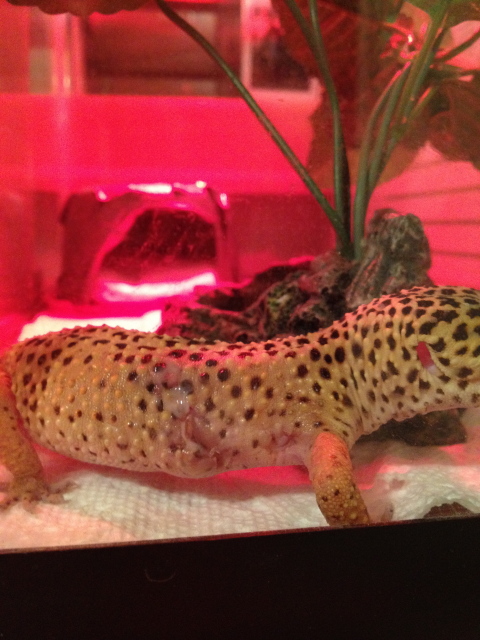 Leopard Gecko Wound
QuestionQUESTION: We own 3 leopard geckos and one of th
Leopard Gecko Wound
QuestionQUESTION: We own 3 leopard geckos and one of th
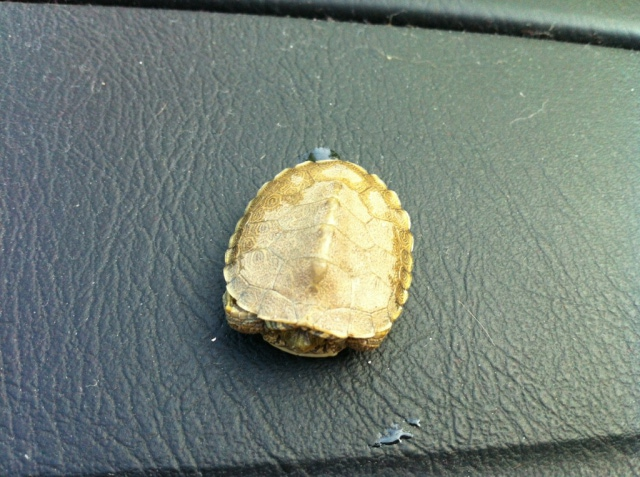 What kind of turtle is this?
Question
george george
i found him at a be
What kind of turtle is this?
Question
george george
i found him at a be
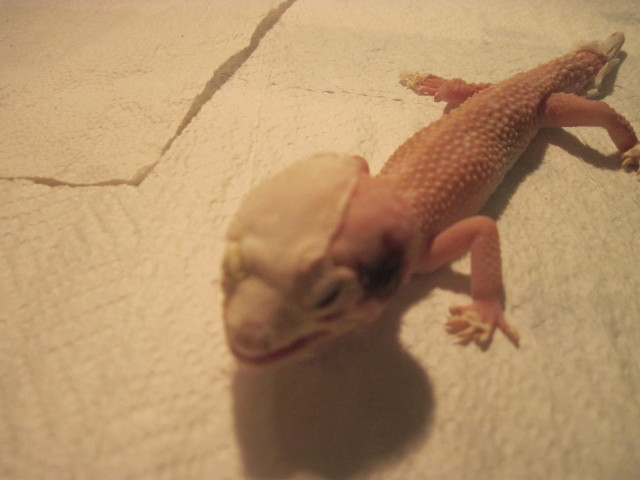 My albino gecko :/
QuestionQUESTION: A few months ago I got two geckos fro
My albino gecko :/
QuestionQUESTION: A few months ago I got two geckos fro
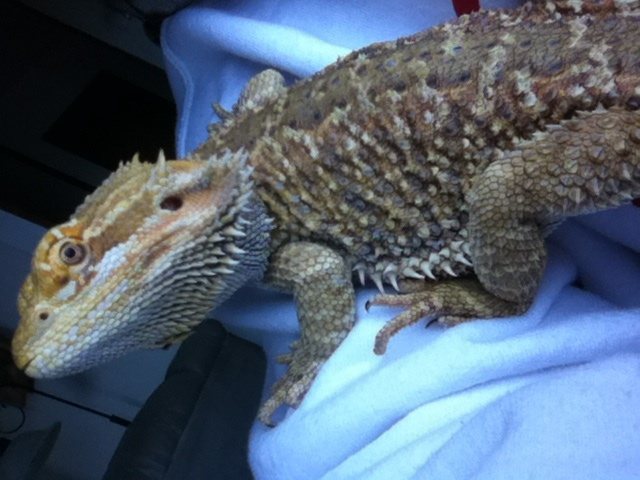 My 9 month old beardie
QuestionOscar
Oscar
QUESTION: My boyfrie
My 9 month old beardie
QuestionOscar
Oscar
QUESTION: My boyfrie
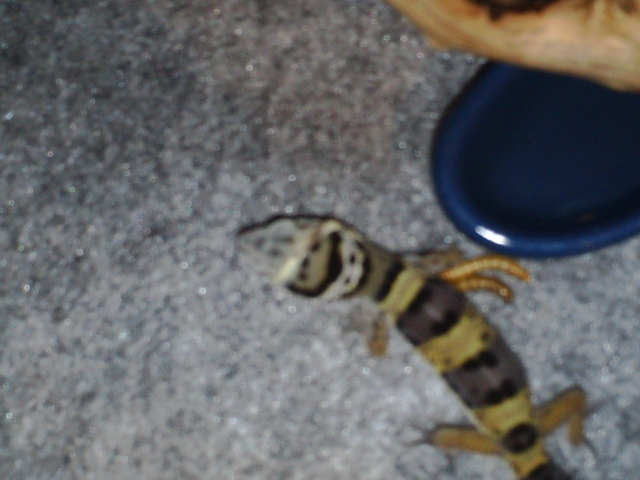 Temperature
QuestionStuck skin on geckos h
QUESTION: My leop
Temperature
QuestionStuck skin on geckos h
QUESTION: My leop